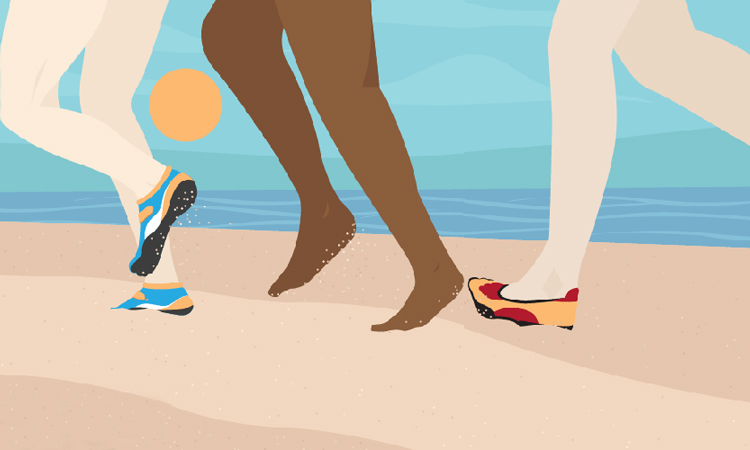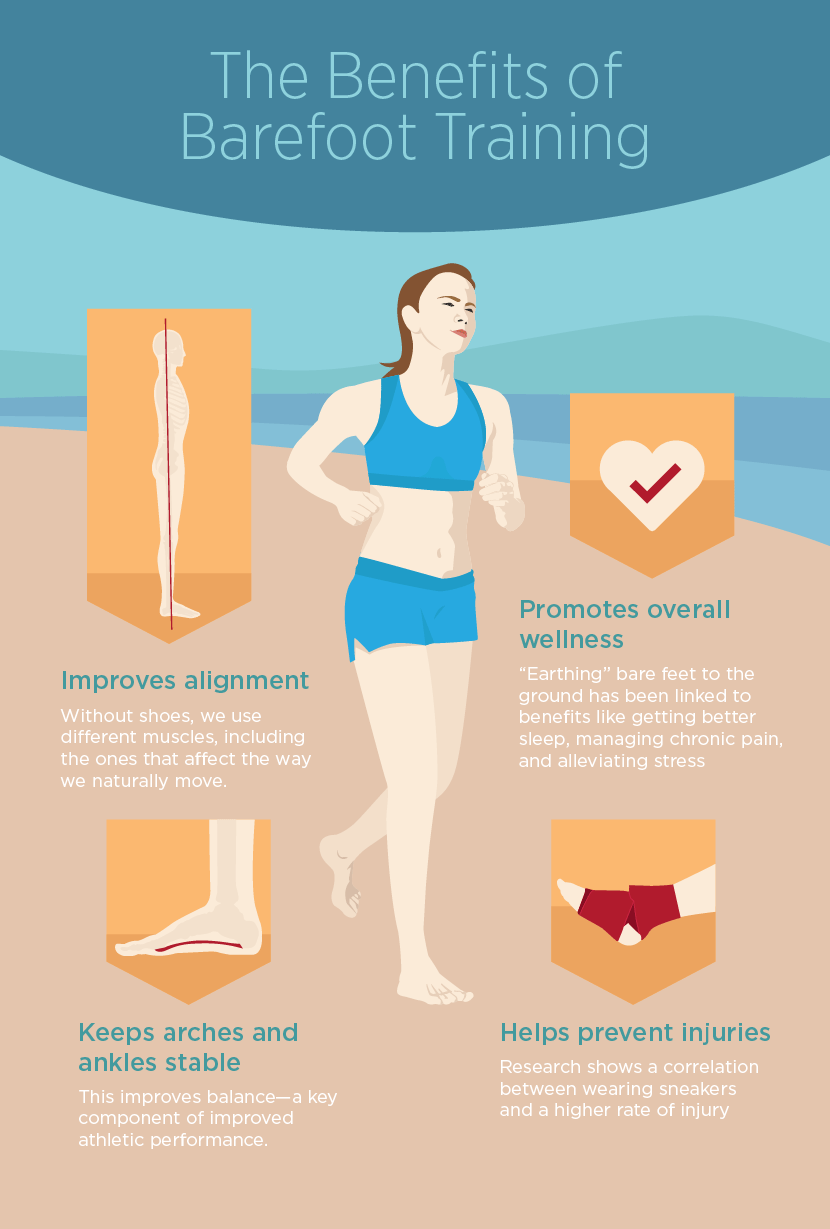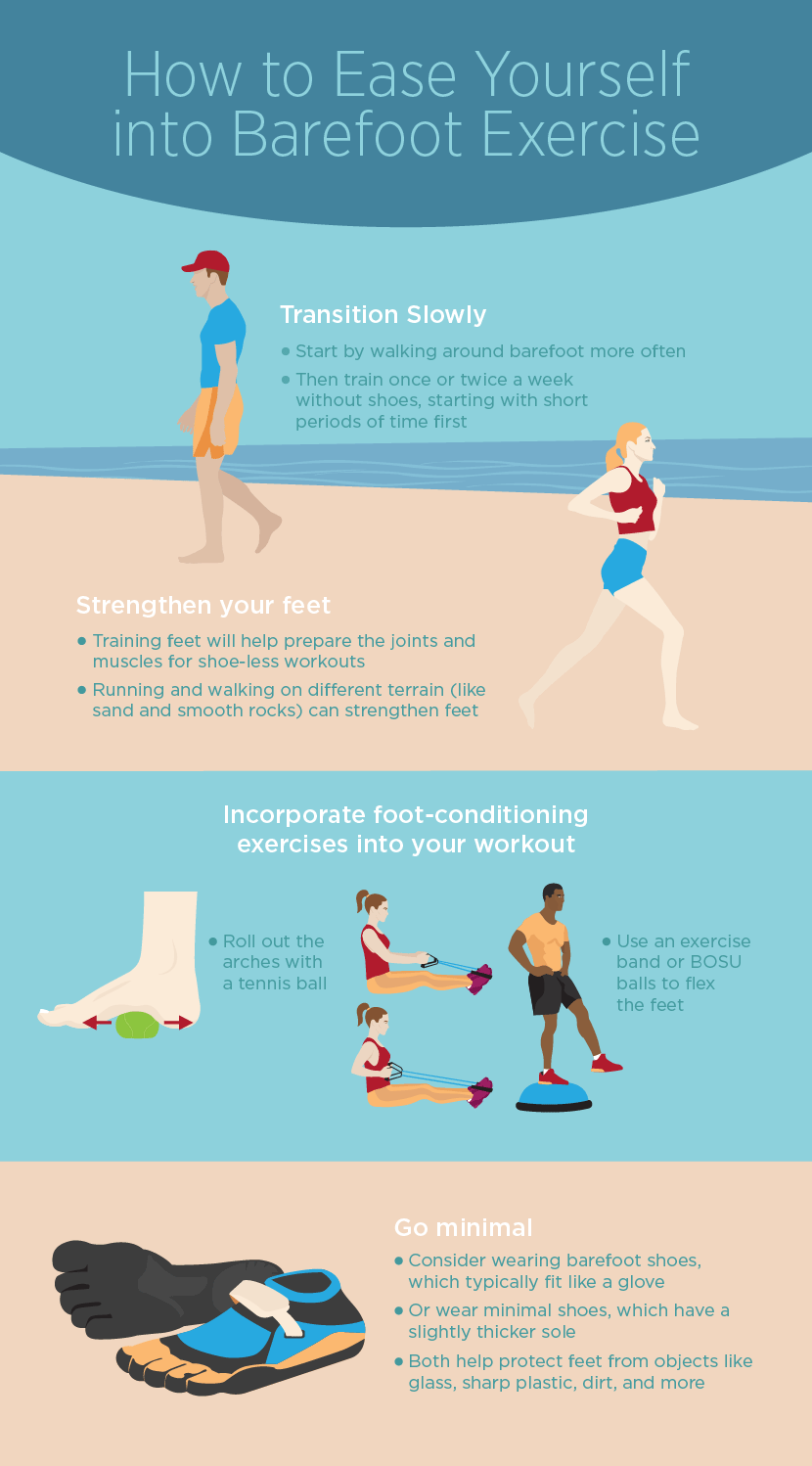To most of us, walking around outside doing anything barefoot seems both unfamiliar and unsettling. But the craze of barefoot training may be catching on, thanks to a host of health benefits.
For starters, when you stand barefoot, your body aligns as nature intended it to do. So when you train or exercise barefoot, you’re able to do the same—which may prevent injuries and stabilize parts of your foot.
But all that doesn’t mean you should jump from shoes into barefoot exercise overnight. As with anything, a slow transition will help ease any shock and reduce the risk of injury. And it’s important to know about the hazards—from hard surfaces and your own body—when barefoot exercising so that you can make accommodations and adjustments along the way.
Interested in barefoot exercising, or want to make tweaks to the beginnings of a barefoot training program? Use this helpful infographic from Fix to connect you and your feet to the ground below.
Running barefoot, also called “natural running,” is a fitness movement many of us have probably heard of. The act of ditching shoes to run in minimal sneakers – or no shoes at all – became more popular when people started to recognize going barefoot could reduce the risk of chronic running injuries, such as stress fractures caused by our heels striking cushioned shoes.
The book Born to Run by Christopher McDougall expanded on this idea, which led people to buy minimal footwear such as Vibram FiveFingers and Nike Free shoes. McDougall argued that all humans are designed to run. And for most of our history, we ran better when barefoot or when wearing thin shoes. He also argued that running in shoes actually prevents our bodies from reaching their maximum potential.
So that’s the case for running barefoot. Rumors have it that Arnold Schwarzenegger lifts and strength-trains without shoes. But even if you’re not a bodybuilder, have you ever thought about ditching the shoes before strength work, Tabata drills, or kickboxing? It may be okay to run without shoes – but is it okay to try other workouts without them?
We decided to dig deeper to find out if it’s safe, smart, and helpful to train barefoot.
Feet as Foundation
Fun fact: Your foot has 28 bones, 38 muscles, 35 joints, and 56 ligaments. Our feet really are our foundation, and with each step they absorb shock. Once we slip into cushioned shoes, some argue that the added support weakens the foot’s ability to absorb shock, which makes us more susceptible to injury.
Think of it another way: Imagine we wore gloves all the time. Would our hands and fingers work the same way? The feet, ankles, and toes need to be strengthened, like any other part of the body. Muscles produce force and absorb shock, so when the skeletal muscles in the feet, ankles, and toes don’t work as they should, stress shifts to connective tissues, tendons, ligaments, and joints.
We’re not saying it’s a good idea to walk around without proper footwear on gravel, dirt roads, and pavement studded with shards of glass, plastic, and other dangerous objects. But there are some definite advantages to going barefoot in the weight room or the safety of your own home.
The Benefits of Bare Feet
The first major benefit of going shoeless is that it helps strengthen our feet, which are the foundation of our bodies. Exercising without shoes (or in minimal footwear) keeps the arches and ankles stable while strengthening the stabilizing muscles in our feet. This improves balance – a key component of improved athletic performance.
Wearing shoes can artificially raise foot arches, making the surrounding muscles unable to do their job and weakening them over time. By keeping the arch closer to the ground, the feet can provide more support for the rest of the body. (Beware, though: Some studies suggest barefoot training can lead to fallen arches and other injuries, so it’s best to start in small doses so your body isn’t surprised by a new way of training.)
Barefoot training can also improve alignment. Without shoes, we use different muscles, including the ones that affect the way we naturally move. Poor alignment can lead to lower back pain, shoulder soreness, and more.
Another key component of barefoot training is its correlation with injury prevention. A lot of injuries, including plantar fasciitis and stress fractures, are caused by overuse. In the long term, one way to avoid overuse injuries is to mobilize and strengthen certain muscles, from the hips and core to the ankles and feet. Moreover, various studies show a correlation between wearing sneakers and a higher rate of injury, especially in running.
Lastly, “earthing” is the concept of our bare feet touching the ground. Interestingly, there have been studies that discuss the beneficial connections between going barefoot and wellness, such as getting better sleep, managing chronic pain, and alleviating stress.
How to Safely Ditch the Shoes
Ready to go barefoot? There’s a way to do it safely to make the most of your shoeless workout. Check out these tips before you ditch your sneakers.
Start Slowly
The rule of thumb is to ease into barefoot training. Don’t wake up ready to throw your sneakers away and do a whole circuit workout barefoot. Instead, transition slowly: Start by walking around barefoot more often, especially in your own home, or outside in your yard. Then train once or twice a week without shoes, and limit it to specific exercises that feel most comfortable without footwear. (More tips on the best exercises to do barefoot below.)
Strengthen your Feet
How frequently do we think about exercising our feet? Probably not so often. But training them will help prepare the joints and muscles for shoeless workouts. Running in sand and walking on smooth rocks is a great place to start. From there, try some foot conditioning exercises to prep, such as rolling out the arches with a tennis ball, and using exercise bands and BOSU balls to flex the feet and build strength in the body’s foundation.
Go Minimal
There are many reasons to use minimal shoes versus going completely barefoot – including protecting feet. Many mainstream athletic companies now include barefoot and minimal shoes, so it should be easy to find a pair that works for you. The main difference between the two: Barefoot shoes are designed to give people a true barefoot experience and typically fit like a glove. Minimal shoes have a slightly thicker sole. Either way, some type of natural shoe is important to protect feet from objects like glass, sharp plastic, dirt, and more.
Read the rules
Before leaving shoes behind in the locker room, make sure it’s okay to walk around barefoot at the gym. For sanitary purposes, many gyms ask members to stick to certain footwear. When push comes to shove, try wearing barefoot or minimal shoes to protect feet from sharp objects and keep germs at bay.
Stick to Certain Exercises
The best way to go barefoot is to start by walking barefoot more regularly on safe surfaces. From there, try certain bodyweight exercises, such as push-ups, squats, and lunges. Once you’re comfortable with those, you can try movements that include equipment (deadlifts and kettlebell swings, for example), but make sure you feel super comfortable to avoid dropping the weight on your feet. To get in some cardio, try boxing, sprints, dance classes, and yoga without shoes. Especially when starting out, skip cardio machines when barefoot and avoid high-impact workouts for an extended period of time, like a 30-minute CrossFit WOD or other intense interval workout.
Barefoot training is a great way to strengthen important muscles in the feet, which could help prevent injury and even improve athletic performance. The key to doing it right is to start slow and train safely. Start gradually and see how barefoot training feels for you. Research on the pros and cons of exercising without shoes is still in the beginning stages, so it’s important to listen to your body above all.
“Lose the Shoes” by Laura Schwecherl was originally published on Fix Blog.






